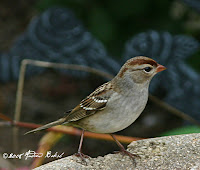On September the 20th, I volunteered with the American Littoral Society and New York City Audubon, in the Annual International Coastal Cleanup. This initiative spearheaded by the Littoral Society, is an effort to clean up our beaches and also to compile data on the thrash collected, in order to derive solutions to the problems…usually the source of the garbage.
My first stop was Brighton Beach where I was supposed to do a media event on behalf of the NYC Audubon; however, I learned from Candace Khaokam, NYC Audubon representative and site captain, that the video folks were going to be late because they had to make a stop at Prospect Park and since no timetable was given for their arrival at Brighton Beach I decided that it was not worth waiting. Also, I had another commitment over at Plum Beach where I was expected to assist my friend Don Riepe in the cleanup effort at that site and so at around 10:00 A.M. I headed out to Plum Beach.
Plum Beach, which is part of Gateway National Recreation Area, is located just past Sheepshead Bay. It is a beautiful but filthy (due to neglect) stretch of sand just off of the Belt Parkway, a major highway that runs through the boroughs of Queens and Brooklyn New York. The area, attracts people from all walks of life both the good and the bad. Visitors include, wind surfers, bikers, Hindu religious practitioners who perform rites in the water, sea shell collectors, sun bathers, birders and just casual visitors out for a stroll on the beach. Unfortunately, this location also attracts drug activities and individuals who use the desolate dunes to engage in lewd acts. In fact, the nefarious activities got to the point where the City Parks Department and National Park Service agreed to impose a
curfew as of August 8th 2008, which made the parking lot and beach area off limits from 9:00 P.M. to 6:00 A.M.
Yet despite some of the negativity, Plum Beach remain a location full of potential and it is in the Spring, when the Beach Plums are in bloom and the horse shoe crabs are around that one gets an appreciation of how important this site is in the ecological order. This and because it is important to keep our shorelines clean for our Shorbeirds, are the reasons why I return year after year to participate in the cleanup efforts. After all, as a bird watcher, I have a vested interest in creating an environment that is bird friendly, which in turn will encourage more visits from our feathered friends.
On Saturday, the weather was great, though the volunteer turnout was lower than I expected. Nevertheless, some of my regular volunteers who participated with me over the past years when I was the beach cleanup captain did came out…thank you Lillian and Elda for your continued support. Our volunteers included Grad Students from City College, DEP (Sarah Ralph, and crew), American Littoral Society, New York City Audubon and other volunteers.
As usual, teams were formed, some to do regular garbage retrieval and others who were assigned to collect plastic bottles. We cleaned up to around noon when the teams broke for lunch. After lunch, we headed up the bike path to a section that goes off into the dunes. At that location, we met DEP representative Sarah Ralph and her crew, and joined them in planting Beach and Spartina Grass. The teams worked quickly and very well with each other and soon we had all the grass plugs into the ground. We ended up completing the day’s activities around 3:30 P.M. The next cleanup for Plum Beach is Earth Day 2009, which is in the Spring; hopefully, we get a larger turnout. Here are some photos from the event.

Graduate Students from City College helping out.

Cleaning the litter at Plum Beach.

Yes, they do fish at Plum Beach; though the fisherman indicated this one would be thrown back into the water since it was not edible.

Don found a moment to strike a pose in the midst of gathering the tools needed for planting.

Volunteer Planting Spartina Grass.

This is what the Spartina Grass should look like when it is fully grown.

Volunteers pose with the collected garbage.

Volunteers pose with Beach Grass plugs that were planted.




















































